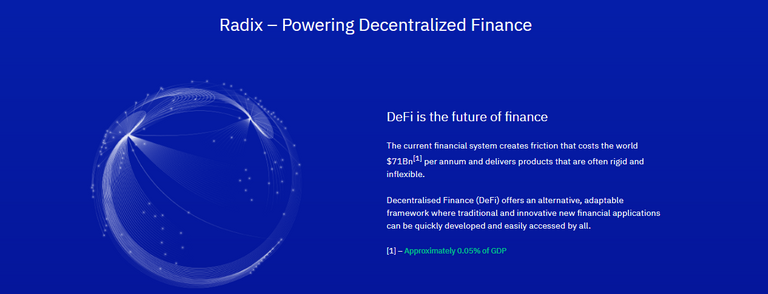
Radix DLT makes a decentralized cash understanding that gives consistent access, liquidity, and programmability to each bit of leeway on earth. In a critical advancement accomplishment a year prior, the Radix bunch crushed the key test of DeFi adaptability, coming to more than 1 million trades each second with their development, throughput multiple times the NASDAQ at its top. The gathering is at present centered around concluding their show, completely anticipating their fundamental net dispatch.
Radix has two layers: the Radix Engine and in this way the Radix Ledger. The system behind Radix is that the application layer for Radix is the part that creators have a legitimate association with. In spite of the fact that it is hypothetically practically identical to a virtual machine gave by sharp arrangement stages, for example, Ethereum or Hyperledger, the Radix Engine can change its look and feel from the standard savvy contract improvements.
The Radix Engine makes it conceivable to rapidly and flawlessly make applications and business situations that exploit the genuine advantages of DLT, yet it takes some mental dabbling. This blog entry uncovers another procedure for building DLT-based applications with Radix, with substantially less multifaceted nature.
Today Radix DLT is gradually striving for growth. Very soon Radix token turns into a coin that will be willing to buy on exchanges.The project is being effectively developed and expanded by new entertainment services. Our team prepares video records, support manuals and online chats with direct round-the-clock dialogs.Become a member of Radix DLT project today. Follow us on social media and messengers. We'll develop this crypto dream together.Radix DLT uses the latest standards of digital wallet management and provide our users with an intuitive layout, powerful and lightning-fast features, and maximum security of funds.Radix this is a reliable project with excellent characteristics and a unique idea. This is a great project. I appreciate this very much. I am very hopeful for the success.

The advent of bitcoin, distributed ledger technologies (DLTs) and smart contract platforms have fueled a new era of living research on consensus protocols. Recent developments in the Bitcoin-style Nakamoto consensus, PBFT-like consensus, randomized consensus and others represent advances in fundamental consensus approaches that have various trade-offs in guarantees they can provide to users. Cerberus's progress in parallelizing consensus is based on the Byzantine leadership fault tolerance (BFT) consensus approach.
DeFi spoke to administrative unbundling regarding money that can be sewn together through the open convention of shared decentralization, if the web is a data uprising, this is the advantage of upheaval. In the end, this development will largely be invisible to ordinary buyers, who will only benefit faster, more responsive and significantly more proficient in monetary administration with better returns.
What are the Benefits of Decentralized Finance?
Decentralized money uses three main standards from the Ethereum blockchain to unlock liquidity and development, enhance monetary security and candor, and support an integrated and normalized financial framework.
Programmability: Smart deals that can be programmed extraordinarily, mechanize the implementation and empower the production of instruments related to new money and sophisticated resources.
Immutability: Sealed information coordination over blockchain decentralized design expands security and auditability.
Interoperability: The Ethereum composite programming stack ensures that the DeFi conventions and applications work to coordinate and complement each other.
The current decentralized money application is based on conventions that are not intended to address the problems and administrative requirements of DeFi. Radix makes use of our important innovation developments to become the main layer 1 convention that explicitly works to serve the fast-growing DeFi industry. Our latest form from Radix Economics is far more difficult than the previous version. Although we accept everything that stable decentralized storage that has significant value to the world is very important, we listen to your criticism carefully. We briefly looked at the various things we needed to convey to make this innovation successful for the world and concluded that the main symbol that triggers Radix to organize should not be a proper token for the system to work.
London-based Radix is building a money decentralization convention (DeFi) which is intended to provide frictionless access, liquidity and programmability for every benefit on the planet. Erosion in our worldwide budget framework currently costs partners $ 71 billion every year. Rapid ascent DeFi offers options that contrast with the norm through a creative and versatile structure.
At Radix we are building a decentralized open record that has the speed and adaptability to be truly global and open to everyone. We focus on guaranteeing full open control of the system and have effectively released our code, sharing updates as they are made on the go.
Radix DLT is building a decentralized money convention that provides unrestricted access, liquidity, and programmability for all benefits on the planet. In achieving a significant innovation a year ago, the Radix group defeated the main issue of DeFi's flexibility by reaching more than 1 million exchanges every second with their innovation, throughput more than 5x higher than NASDAQ at its peak. The group is currently centered around refining the convention to fully expect the principle of clean shipments.
Radix is made of two layers: the Radix Engine and the Radix Ledger. Radix Engine is an application layer for Radix parts that designers communicate lawfully. While comparable in ideas to virtual machines given by sharp agreement stages such as Ethereum or Hyperledger, the Radix Engine is a change in view of the increase in conventional smart contracts.

The Radix engine makes it possible to quickly and without doubt create business applications and frameworks that exploit the original advantages of DLT, but that rather requires psychological steps. This blog post reveals another strategy for building DLT-based applications with Radix, with far less complexity.
The Radix engine allows designers to easily plan business resources for pre-assembled Radix components. Radix provides (and continues to create) a variety of segments that can be adjusted to allow designers to characterize resources that coordinate the needs of the original world value-based framework. This structure's square style segment is merged into the Radix Engine Library which runs inside Radix Engine on Radix arranging nodes.
The asset-oriented way of the Radix Engine to handle improved DLT applications has various advantages.
Development is very unraveling: Designers can concentrate on demonstrating the implementation of business procedures that must be implemented, as opposed to building them without preparation in universally useful programming languages.
The next value-based: framework is a spring of truth that is safer by default. Proper implementation of business processes is included in the sense that local resources are not an element of prudence in terms of checking intelligent agreement codes. The right action on our profits can be imagined, therefore the accuracy of the fountain of truth is ensured by DLT.
DLT applications are increasingly compatible: Because usability is communicated to the extent that resources model the things the business thinks, new uses can be instinctively made from current resources without changing the brilliant black box of agreement. The capacity to build unexpected usability with existing parts is extraordinary and will be discussed further in the next post.
Model
Cerberus solves the problem of state machine replication (SMR) fault-tolerant distribution of states across many nodes. Cerberus is built on a BFT-style consensus while retaining the two main properties of BFT:
- Safety when asynchronous, survivability when synchronous
Preference for consistency by availability (that is, safety by liveness during periods of asynchrony)
We also make the following general BFT assumptions in our base model. While we make these assumptions in order to describe a simple form of the Cerberus model, some of these restrictions can be removed in practical implementation (in particular, a set of static nodes). We discuss some of these in the Implementation section of this document.
- Static, world famous set of nodes
- Partial synchronicity (i.e. after some global stabilization time there is an unknown border within which all messages arrive)
- 2f + 1 nodes follow the protocol, where f is the number of Byzantine nodes (per shard in Cerberus case)
- Attackers who are computationally incapable of breaking standard cryptography primitives
- Having a practical threshold signature method for aggregating votes from nodes
Communication between the correct nodes is peer-to-peer, authenticated and reliable
In classic BFT, the client command log is ordered globally so that the correct nodes can agree on the final state. Performance improvements have traditionally been based on "vertical" scaling, or "pushing more commands down." one pipe ".
In practice, applications usually do not require a global ordering of all commands; they only require ordering of commands that are interdependent. Cerberus needs an application layer that defines dependencies so that it can implement partial ordering, only ordering commands that are linked. The Shards of Cerberus represent this dependency relationship between teams. Commands that do not share a partial ordering relationship do not share shards either, and can be safely executed in parallel.
More information about this project you can see the link below:
Author
maikel30
https://bitcointalk.org/index.php?action=profile;u=1835452





















